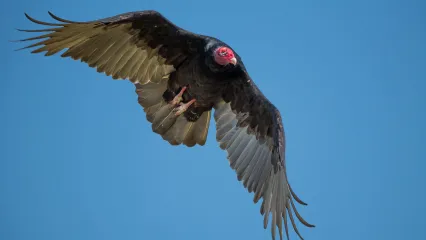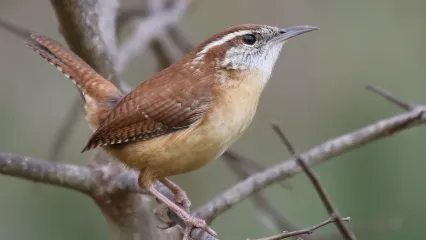
Description
The turkey vulture may not be the most glamorous wildlife species in Oklahoma. but it is none the less an important part of our ecosystem . In short. they take out the trash by feeding on carcasses . Turkey vultures (Cathartes aura) are classified in the same order as storks and flamingos because of their genetic similarities. The Cherokee Nation calls the bird the "peace eagle" because unlike birds of prey, turkey vultures do not kill.
Unlike most birds, vultures have a keen sense of smell and they use this sense in traveling far and wide to find carcasses. These unique birds have the ability to eat anything without coming down with diseases. Their digestion system has the ability to kill any virus and bacteria in the food that the bird eats. Their eating habits are omnivorous, meaning they eat both plant and animal matter. Turkey vultures are not picky about what they eat. They will consume dead mice, muskrats, birds, raccoons, deer, skunks, and coyotes .
Vultures are most often spotted while they are soaring on rising columns of warm air called thermals to save energy as they cover miles of territory. When in group flight. they are called "kettles." Vultures are sociable birds- 75 to 100 have been found together in their nesting areas or feasting together at one time. Their communal roosts are continually used for years by successive generations. Turkey vultures are long lived birds, living up to 20 years in the wild.
Turkey vultures use thermoregulation by spreading their wings and use them as heat exchangers dissipating heat when they are hot or absorbing the morning sun. The next time you see a turkey vulture soaring high over your head, take a moment to appreciate these fascinating birds.
Size
They can stay aflight for hours, with just a few wing flaps. With a wingspan of nearly six feet. turkey vultures can travel up to 140 miles a day.
Habitat
Turkey vultures, found across North and Central America, get their name from the bald, red head, which resembles that of a tom turkey. Immature. turkey vultures are gray all over, however. as adults, the head is not only bright red. but it is also equipped with a hooked, yellow bill. Because of their large size, many people mistake vultures for eagles. However, unlike eagles and other birds of prey, turkey vultures do not kill their own prey. The turkey vulture also often gets the blame for the black vultures behavior. The black vulture, which can be found throughout the Southeast United States, is aggressive and is known to kill small animals.
Life Cycle
They mate for life and have a fascinating courtship dance in which they woo the potential mate. Vultures nest in a variety of locations including tree cavities or rocky ledges. Nests are loosely and crudely built and eggs are laid in late April to early June. The eggs are white with brown markings and incubation takes just about one month. The young vultures fledge quickly and begin to leave the nest at around 10 to 11 weeks of age.


